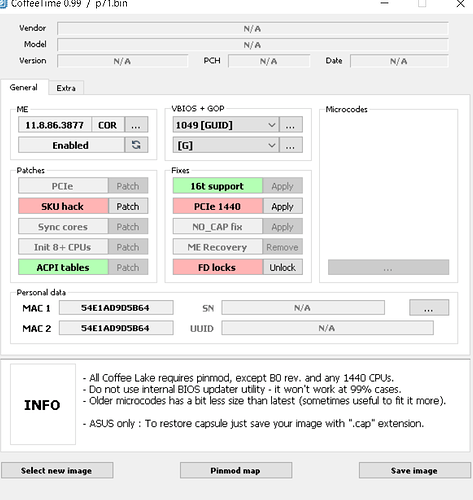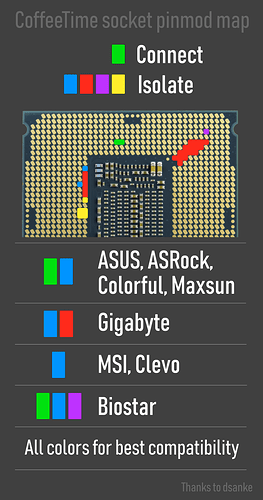Hey, I’m having an issue with an i7 8700k on an ASRock Fatal1ty Z170 Gaming K4/D3 and was hoping people here might be able to help.
Basically, the CPU temperature is very high and I feel like it might not be using the correct sensors for it.
In the BIOS, the temperature rapidly rises after boot until it stabilizes at around 60°C. When booting an OS (Windows 10 and Linux Mint tested), the temperature rises even further until it hits the 90-100°C range and starts throttling to stay there. After idling in the OS for a few minutes (at least Windows, I haven’t double-checked it on Linux yet), the core clocks and voltages go down to idle state, so around 800 MHz, and the temperature goes back down to “stable” 60°C.
This is obviously not correct and how this CPU should run. I initially only covered the pads with kapton tape on the left inner edge, the recommended reversed “L”-shape, as well as the 2 additional pads underneath for safety, however I re-applied the mod and covered all pads shown here, but without luck: https://imgur.com/uEoK5lx
I tried to re-mount the cooler multiple times. I also de-lidded the CPU, but I only used normal thermal paste on the inside for now, since the liquid metal I ordered hasn’t arrived yet. I also have a small 120mm liquid cooler on the way, just to rule out the possibility that somehow my air cooler isn’t making any contact whatsoever, despite it squishing the thermal paste nicely (yes there is no plastic film on it).
Regardless though, none of that changed the issue even a bit. I also tried to disable all but 2 cores, limited the CPU to 3 GHz and reduced the voltage, but even all of those changes at once still didn’t change anything and the behaviour is exactly the same, with the CPU temperature rising to +90°C in the OS right away.
I tried it with and without a dedicated GPU too. No change.
I am using CoffeeTime for this, since the AIO tool in this post doesn’t seem to work for me. Despite the temperature issue however, the system and mod seem to be working. I did try to re-do the BIOS mod multiple times and I always enabled all the patches that mentioned being required for more than 8 threads or coffee lake CPUs. I’m using the latest BIOS version and it seems like BIOS versions 1.x or 2.x don’t work at all. I haven’t tried any other 7.x versions.
I made some screenshots of HWInfo64 for reference. This is with only 2 cores, 3 GHz limit and reduced core voltage (the last picture is after a few minutes at idle): https://imgur.com/a/dxC0TXv
Any idea? Could it be that it’s missing a patch or two that haven’t been necessary on other boards?
Thanks!
![]()



